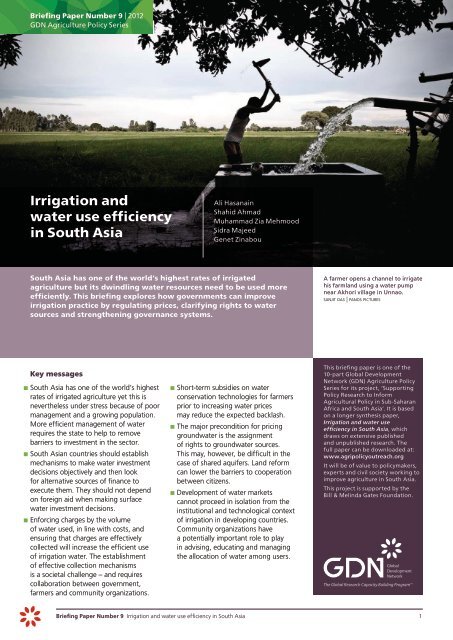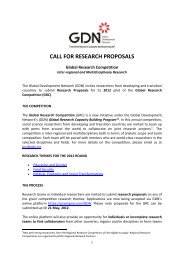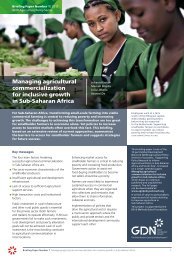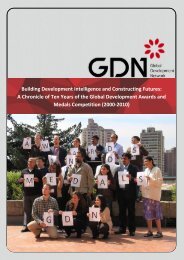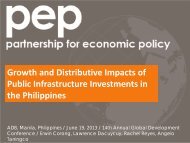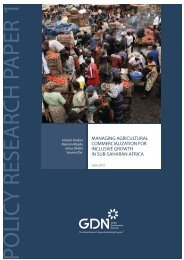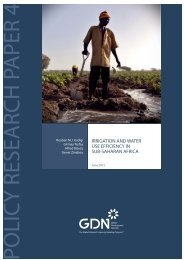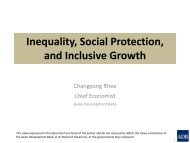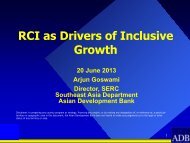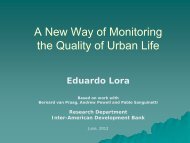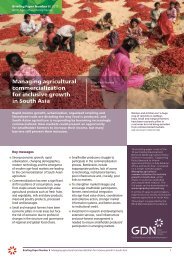Irrigation and water use efficiency in South Asia - Global ...
Irrigation and water use efficiency in South Asia - Global ...
Irrigation and water use efficiency in South Asia - Global ...
Create successful ePaper yourself
Turn your PDF publications into a flip-book with our unique Google optimized e-Paper software.
Brief<strong>in</strong>g Paper Number 9 | 2012GDN Agriculture Policy Series<strong>Irrigation</strong> <strong>and</strong><strong>water</strong> <strong>use</strong> <strong>efficiency</strong><strong>in</strong> <strong>South</strong> <strong>Asia</strong>Ali Hasana<strong>in</strong>Shahid AhmadMuhammad Zia MehmoodSidra MajeedGenet Z<strong>in</strong>abou<strong>South</strong> <strong>Asia</strong> has one of the world’s highest rates of irrigatedagriculture but its dw<strong>in</strong>dl<strong>in</strong>g <strong>water</strong> resources need to be <strong>use</strong>d moreefficiently. This brief<strong>in</strong>g explores how governments can improveirrigation practice by regulat<strong>in</strong>g prices, clarify<strong>in</strong>g rights to <strong>water</strong>sources <strong>and</strong> strengthen<strong>in</strong>g governance systems.A farmer opens a channel to irrigatehis farml<strong>and</strong> us<strong>in</strong>g a <strong>water</strong> pumpnear Akhori village <strong>in</strong> Unnao.sanjit das | panos picturesKey messagesp <strong>South</strong> <strong>Asia</strong> has one of the world’s highestrates of irrigated agriculture yet this isnevertheless under stress beca<strong>use</strong> of poormanagement <strong>and</strong> a grow<strong>in</strong>g population.More efficient management of <strong>water</strong>requires the state to help to removebarriers to <strong>in</strong>vestment <strong>in</strong> the sector.p <strong>South</strong> <strong>Asia</strong>n countries should establishmechanisms to make <strong>water</strong> <strong>in</strong>vestmentdecisions objectively <strong>and</strong> then lookfor alternative sources of f<strong>in</strong>ance toexecute them. They should not dependon foreign aid when mak<strong>in</strong>g surface<strong>water</strong> <strong>in</strong>vestment decisions.p Enforc<strong>in</strong>g charges by the volumeof <strong>water</strong> <strong>use</strong>d, <strong>in</strong> l<strong>in</strong>e with costs, <strong>and</strong>ensur<strong>in</strong>g that charges are effectivelycollected will <strong>in</strong>crease the efficient <strong>use</strong>of irrigation <strong>water</strong>. The establishmentof effective collection mechanismsis a societal challenge – <strong>and</strong> requirescollaboration between government,farmers <strong>and</strong> community organizations.p Short-term subsidies on <strong>water</strong>conservation technologies for farmersprior to <strong>in</strong>creas<strong>in</strong>g <strong>water</strong> pricesmay reduce the expected backlash.p The major precondition for pric<strong>in</strong>gground<strong>water</strong> is the assignmentof rights to ground<strong>water</strong> sources.This may, however, be difficult <strong>in</strong> thecase of shared aquifers. L<strong>and</strong> reformcan lower the barriers to cooperationbetween citizens.p Development of <strong>water</strong> marketscannot proceed <strong>in</strong> isolation from the<strong>in</strong>stitutional <strong>and</strong> technological contextof irrigation <strong>in</strong> develop<strong>in</strong>g countries.Community organizations havea potentially important role to play<strong>in</strong> advis<strong>in</strong>g, educat<strong>in</strong>g <strong>and</strong> manag<strong>in</strong>gthe allocation of <strong>water</strong> among <strong>use</strong>rs.This brief<strong>in</strong>g paper is one of the10-part <strong>Global</strong> DevelopmentNetwork (GDN) Agriculture PolicySeries for its project, ‘Support<strong>in</strong>gPolicy Research to InformAgricultural Policy <strong>in</strong> Sub-SaharanAfrica <strong>and</strong> <strong>South</strong> <strong>Asia</strong>’. It is basedon a longer synthesis paper,<strong>Irrigation</strong> <strong>and</strong> <strong>water</strong> <strong>use</strong><strong>efficiency</strong> <strong>in</strong> <strong>South</strong> <strong>Asia</strong>, whichdraws on extensive published<strong>and</strong> unpublished research. Thefull paper can be downloaded at:www.agripolicyoutreach.orgIt will be of value to policymakers,experts <strong>and</strong> civil society work<strong>in</strong>g toimprove agriculture <strong>in</strong> <strong>South</strong> <strong>Asia</strong>.This project is supported by theBill & Mel<strong>in</strong>da Gates Foundation.Brief<strong>in</strong>g Paper Number 9 <strong>Irrigation</strong> <strong>and</strong> <strong>water</strong> <strong>use</strong> <strong>efficiency</strong> <strong>in</strong> <strong>South</strong> <strong>Asia</strong> 1
The challenges <strong>in</strong> more detailGround<strong>water</strong> challengesGround<strong>water</strong> irrigation is a core elementof livelihood creation programs for poorpeople <strong>in</strong> many regions. It forms the basisof 60 per cent of irrigation <strong>in</strong> India <strong>and</strong> isoften supported by subsidies for tube wellequipment <strong>and</strong> pump<strong>in</strong>g electricity. Thereis little scope for further development<strong>in</strong> most <strong>South</strong> <strong>Asia</strong>n countries, with theexception of some parts of India <strong>and</strong>Nepal. Nevertheless, governments persistwith extraction policies, rather thanemphasiz<strong>in</strong>g the importance of <strong>in</strong>creas<strong>in</strong>g<strong>water</strong> <strong>use</strong> <strong>efficiency</strong>. This creates a riskof ground<strong>water</strong> depletion <strong>and</strong>, if cropsfail, of food shortages <strong>and</strong> the subsequentab<strong>and</strong>onment of whole clusters ofvillages, as has been the case <strong>in</strong> <strong>South</strong>ernRajasthan, coastal Saurashtra, Tamil Nadu<strong>and</strong> Northern Gujarat <strong>in</strong> India.There is little disagreement amongpolicymakers as to what ideal policy<strong>in</strong>terventions would look like or on howto set up a market <strong>in</strong> ground<strong>water</strong>. These<strong>in</strong>clude the formulation <strong>and</strong> enforcementof ground<strong>water</strong> laws, establish<strong>in</strong>gunambiguous tradable property rightsfor <strong>water</strong> – treat<strong>in</strong>g ground<strong>water</strong> asan economic good <strong>in</strong> terms of pric<strong>in</strong>g –<strong>and</strong> implement<strong>in</strong>g a licens<strong>in</strong>g <strong>and</strong>permit system to regulate ground<strong>water</strong>extraction. However, a lack of clarityover property rights often prevents<strong>in</strong>dividuals from <strong>in</strong>vest<strong>in</strong>g <strong>in</strong> <strong>water</strong>extraction <strong>and</strong> no <strong>South</strong> <strong>Asia</strong>n countryhas been able to adopt these measureseffectively on a sufficiently large scale.In the absence of ‘tied ownership’(ie the l<strong>in</strong>k<strong>in</strong>g of <strong>water</strong> rights to propertyrights), the prevalent rule tends to be’first possession’ (whoever pumps the<strong>water</strong> is its rightful owner), <strong>in</strong>creas<strong>in</strong>gthe danger of overexploitation. Forground<strong>water</strong> markets to be successful,the most important preconditionis assign<strong>in</strong>g <strong>and</strong> enforc<strong>in</strong>g rights <strong>in</strong>a bid to limit over-extraction, a difficultgoal for governments.Surface <strong>water</strong> managementSurface <strong>water</strong> irrigation structuressuch as dams, canal irrigation <strong>and</strong> large<strong>water</strong> storage systems are usually managedby the state. In the past this <strong>in</strong>volvedsubstantial foreign <strong>in</strong>vestment, whichhas s<strong>in</strong>ce decl<strong>in</strong>ed. Surface <strong>water</strong><strong>in</strong>frastructure <strong>in</strong>vestment is perhaps themost important area of focus for <strong>South</strong><strong>Asia</strong>n governments, that must nowavoid becom<strong>in</strong>g dependent on aid whenmak<strong>in</strong>g such <strong>in</strong>vestment decisions.In centrally managed systems, <strong>water</strong> ispriced for two reasons: to cover operation<strong>and</strong> ma<strong>in</strong>tenance costs <strong>and</strong> to encouragefarmers to <strong>use</strong> <strong>water</strong> carefully. Where<strong>water</strong> prices do not fully recover the costs,the quantity of <strong>water</strong> consumed will begreater than is socially optimal.Governments have typically based<strong>water</strong> charges on the size of the farmaccess<strong>in</strong>g the <strong>water</strong> source or on thetype of crop be<strong>in</strong>g irrigated. This, however,does not allow for the fact that similartypes of <strong>use</strong>rs will <strong>use</strong> vary<strong>in</strong>g quantitiesof <strong>water</strong> for different purposes, <strong>and</strong> withvariable productivity.Volumetric charges set at unit costare harder to implement, but preferable.At present, surface <strong>water</strong> prices are toolow <strong>and</strong> unmonitored (<strong>and</strong> thus untaxed).Farmers have no direct economic <strong>in</strong>centiveto be efficient or careful us<strong>in</strong>g <strong>water</strong>.For a surface <strong>water</strong> market to function,it must have well-def<strong>in</strong>ed <strong>water</strong> rights,a consistent way to measure <strong>water</strong> <strong>use</strong>,enforcement <strong>and</strong> sanction<strong>in</strong>g mechanisms<strong>and</strong> specifications concern<strong>in</strong>g return flows.Brief<strong>in</strong>g Paper Number 9 <strong>Irrigation</strong> <strong>and</strong> <strong>water</strong> <strong>use</strong> <strong>efficiency</strong> <strong>in</strong> <strong>South</strong> <strong>Asia</strong> 3
‘ The relative prices of <strong>water</strong> <strong>in</strong> Pakistanare absurd: a one-liter bottle of <strong>water</strong> costs30 rupees whereas a farmer gets 60,000liters of surface <strong>water</strong> for 1 rupee. Theresult is that people are very careful withbottled <strong>water</strong> supplies <strong>and</strong> very wastefulwith agricultural <strong>water</strong> supplies.’Nawaz KhanSenior Research AssociateFood <strong>and</strong> Agriculture DivisionPlann<strong>in</strong>g CommissionIslamabadPric<strong>in</strong>g ground<strong>water</strong>Markets <strong>in</strong> ground<strong>water</strong> are fundamentallydifferent. They are localized <strong>and</strong> personal<strong>and</strong> their <strong>in</strong>frastructure requirementsare smaller. Ground<strong>water</strong> trade alreadyexists <strong>in</strong> various parts of <strong>South</strong> <strong>Asia</strong> <strong>and</strong>there is a high level of competition for<strong>in</strong>vestment <strong>in</strong> <strong>water</strong> pumps. Among thosetrad<strong>in</strong>g <strong>water</strong>, suppliers of the <strong>water</strong> viawells <strong>and</strong> pumps <strong>use</strong> a higher proportionof their well capacity <strong>and</strong> enjoy a higherreturn on their <strong>in</strong>vestment.The benefits to <strong>water</strong> buyers <strong>in</strong>clude betteraccess to irrigation <strong>water</strong> <strong>and</strong> <strong>in</strong>creasedcrop output, lead<strong>in</strong>g to more opportunitiesfor hir<strong>in</strong>g unskilled agricultural laborers <strong>and</strong><strong>in</strong> some cases the added bonus of lowered<strong>water</strong> tables <strong>in</strong> <strong>water</strong>logged areas.However, as discussed earlier, the absenceof ’tied ownership’ (ie the l<strong>in</strong>k<strong>in</strong>g of <strong>water</strong>rights to property rights), ‘first possession’(whoever pumps the <strong>water</strong> is its rightfulowner) prevails. This creates an <strong>in</strong>centiveto pump <strong>water</strong> aggressively, <strong>and</strong> raises thedanger of overexploitation.The most effective condition for wast<strong>in</strong>gless <strong>water</strong> is assign<strong>in</strong>g <strong>and</strong> enforc<strong>in</strong>g ’tiedownership’ rights that limit over-extraction.A Bhumji woman carries anirrigation tube <strong>in</strong> the villageof Dhusra, <strong>in</strong> the Indian’sstate of Jharkh<strong>and</strong>, on the wayto one of her fields.heldur netocny | panos picturesBrief<strong>in</strong>g Paper Number 9 <strong>Irrigation</strong> <strong>and</strong> <strong>water</strong> <strong>use</strong> <strong>efficiency</strong> <strong>in</strong> <strong>South</strong> <strong>Asia</strong> 5
Recommendationsp Self-sufficiency <strong>in</strong> f<strong>in</strong>anc<strong>in</strong>g<strong>South</strong> <strong>Asia</strong>n governments must lookat domestic sources for f<strong>in</strong>anc<strong>in</strong>g oflarge-scale surface <strong>water</strong> <strong>in</strong>frastructurep Us<strong>in</strong>g <strong>water</strong> <strong>use</strong>r associations <strong>and</strong>farmer organizations more effectivelyThere is potential for exp<strong>and</strong><strong>in</strong>g the roleof <strong>use</strong>rs <strong>in</strong> surface <strong>water</strong> <strong>in</strong>frastructureoperation <strong>and</strong> ma<strong>in</strong>tenance; countriesneed to learn how <strong>water</strong> <strong>use</strong>r associations<strong>and</strong> farmer organizations can be <strong>use</strong>dmore effectively.Kareze irrigation – a traditional <strong>and</strong> susta<strong>in</strong>ableground<strong>water</strong> systemA kareze is an unl<strong>in</strong>ed tunnel <strong>in</strong> the hillside, br<strong>in</strong>g<strong>in</strong>g <strong>water</strong>by free flow from underground aquifers to be <strong>use</strong>d forsurface irrigation. This ancient system harvests ground<strong>water</strong>through a series of wells that beg<strong>in</strong> at the base of mounta<strong>in</strong>s<strong>and</strong> l<strong>in</strong>k with underground channels to br<strong>in</strong>g ground<strong>water</strong>to the surface. Karezes are prevalent <strong>in</strong> the world’s highl<strong>and</strong>sirrigat<strong>in</strong>g 15 million hectares – 6 per cent of the world’sirrigated l<strong>and</strong>s. Half of these are <strong>in</strong> Iran <strong>and</strong> the rest are<strong>in</strong> Afghanistan, Pakistan, Central <strong>Asia</strong>n states, Oman, theMaghreb, Morocco <strong>and</strong> Mexico.A survey of over 1,146 karezes <strong>in</strong> Balochistan, Pakistan,<strong>in</strong>dicates that their construction <strong>and</strong> ma<strong>in</strong>tenance isstill based on traditional participatory approaches. Karezeprovided <strong>water</strong> susta<strong>in</strong>ably until the 1970s when, withthe <strong>in</strong>creas<strong>in</strong>g take-up of tube wells, the <strong>water</strong> tablestarted decl<strong>in</strong><strong>in</strong>g, adversely affect<strong>in</strong>g the kareze system.Various organizations are undertak<strong>in</strong>g kareze modernizationthrough the improvement of mother wells <strong>and</strong> <strong>water</strong> flowcontrol devices, the l<strong>in</strong><strong>in</strong>g of <strong>water</strong> conveyance channels withPVC pipes between the two wells, by the l<strong>in</strong><strong>in</strong>g of verticalwells <strong>and</strong> the storage of <strong>water</strong> at its dest<strong>in</strong>ation.p More efficient collection of<strong>water</strong> chargesThe greatest <strong>efficiency</strong> ga<strong>in</strong>s fromthe exist<strong>in</strong>g <strong>in</strong>frastructure may come fromenforc<strong>in</strong>g <strong>water</strong> charges, based on thevolume <strong>use</strong>d, that are proportional to costs,<strong>and</strong> ensur<strong>in</strong>g that charges are collectedeffectively <strong>and</strong> <strong>in</strong> a timely manner.p Demonstrate the ancillary benefitsof <strong>water</strong> managementFarmers should be <strong>in</strong>formed throughextension services of the advantages<strong>in</strong>herent <strong>in</strong> the judicious <strong>and</strong> equitablemanagement of <strong>water</strong>: improved crops,fewer pests <strong>and</strong> monetary sav<strong>in</strong>gs.p Short-term subsidiesShort-term subsidies on <strong>in</strong>vestments<strong>in</strong> adopt<strong>in</strong>g <strong>water</strong> conservationtechnologies <strong>and</strong> l<strong>in</strong>k<strong>in</strong>g subsidies withcharge <strong>in</strong>creases may reduce resistanceto rais<strong>in</strong>g <strong>water</strong> prices.Private sector <strong>in</strong>volvement <strong>in</strong>the adoption of drip <strong>and</strong> spr<strong>in</strong>klerirrigation <strong>in</strong> IndiaDrip irrigation was <strong>in</strong>troduced <strong>in</strong> TamilNadu <strong>in</strong> the 1970s but its adoptionrema<strong>in</strong>ed slow until the 1980s beca<strong>use</strong>of a lack of promotion. In 1995, theGovernment of India <strong>in</strong>volved thecorporate sector <strong>in</strong> adopt<strong>in</strong>g drip <strong>and</strong>spr<strong>in</strong>kler irrigation. The company Ja<strong>in</strong><strong>Irrigation</strong> Systems Private Limited startedpromot<strong>in</strong>g spr<strong>in</strong>kler/drip irrigationsystems through local manufactur<strong>in</strong>g<strong>and</strong> by provid<strong>in</strong>g <strong>in</strong>tegrated servicesto farmers. This enhanced farmers’will<strong>in</strong>gness to pay for premium <strong>use</strong>of <strong>water</strong> <strong>and</strong> resulted <strong>in</strong> high compliancefrom irrigation eng<strong>in</strong>eers <strong>and</strong> privatesector firms. This was the beg<strong>in</strong>n<strong>in</strong>gof large-scale technology adoption<strong>in</strong> India for high-value horticulture us<strong>in</strong>ghigh-<strong>efficiency</strong> irrigation systems.Brief<strong>in</strong>g Paper Number 9 <strong>Irrigation</strong> <strong>and</strong> <strong>water</strong> <strong>use</strong> <strong>efficiency</strong> <strong>in</strong> <strong>South</strong> <strong>Asia</strong> 7
Key referencesKhuda Bakhsh, Ishtiaq Hassan <strong>and</strong>Asif Maqbool (2005)‘ Impact assessment of zero tillagetechnology <strong>in</strong> rice wheat system:A case study from Pakistani Punjab’,Electronic Journal of Environmental,Agricultural <strong>and</strong> Food Chemistry,vol 4, no 6, pp1132–7R<strong>and</strong>olph Barker <strong>and</strong>François Molle (2007)Evolution of irrigation <strong>in</strong> <strong>South</strong><strong>and</strong> <strong>South</strong>east <strong>Asia</strong>, InternationalWater Management Institute(IWMI), Comprehensive Assessmentof Water Management <strong>in</strong> AgricultureProgram, Research Report 5, Colombo,Sri Lanka: IWMIAriel D<strong>in</strong>ar, Mark W Rosegrant<strong>and</strong> Ruth Me<strong>in</strong>zen-Dick (1997)‘ Water allocation mechanisms:Pr<strong>in</strong>ciples <strong>and</strong> Examples’, World BankPolicy Research Work<strong>in</strong>g Paper No 1779,Wash<strong>in</strong>gton DC: World Bank <strong>and</strong> IFPRIAriel D<strong>in</strong>ar, Trichur Balakrishnan<strong>and</strong> Joseph Wambia (1998)‘ Political economy <strong>and</strong> political risks of<strong>in</strong>stitutional reforms <strong>in</strong> the <strong>water</strong> sector’,World Bank Policy Research Work<strong>in</strong>g PaperNo. 1987, Wash<strong>in</strong>gton DC: World BankEsther Duflo, Hanna Rema <strong>and</strong>Stephen Ryan (forthcom<strong>in</strong>g)‘ Incentives work: Gett<strong>in</strong>g teachers to cometo school’, American Economic ReviewMatthew McCartney <strong>and</strong>Vladimir Smakht<strong>in</strong> (2010)‘ Water storage <strong>in</strong> an era of climate change:Address<strong>in</strong>g the challenge of <strong>in</strong>creas<strong>in</strong>gra<strong>in</strong>fall variability’, blue paper, Colombo,Sri Lanka: IWMIFrançois Molle <strong>and</strong> Jeremy Berkoff (2007)‘ Water pric<strong>in</strong>g <strong>in</strong> irrigation: Mapp<strong>in</strong>gthe debate <strong>in</strong> the light of experience’<strong>in</strong> <strong>Irrigation</strong> <strong>water</strong> pric<strong>in</strong>g (eds F Molle<strong>and</strong> J Berkoff), Wall<strong>in</strong>gford, Oxon:Centre for Agricultural BioscienceInternational (CABI)A Narayanamoorthy (2006)Potential for drip <strong>and</strong> spr<strong>in</strong>kler irrigation<strong>in</strong> India, Pune: Gokhale Institute ofPolitics <strong>and</strong> EconomicsTushaar Shah (2007)‘ The ground<strong>water</strong> economy of <strong>South</strong>-<strong>Asia</strong>:An assessment of size, significance <strong>and</strong>socio-ecological impacts’, <strong>in</strong> M Giordano<strong>and</strong> KG Villholth (eds), The agriculturalground<strong>water</strong> revolution: Opportunities<strong>and</strong> threats to development, Wall<strong>in</strong>gford,Oxon: CABI, pp7–36The full paper <strong>Irrigation</strong> <strong>and</strong> Water UseEfficiency <strong>in</strong> <strong>South</strong> <strong>Asia</strong> is available for downloadat www.agripolicyoutreach.orgIt was written by:Dr. Ali Hasana<strong>in</strong>Lahore University of Management Sciences, PakistanDr. Shahid AhmadPakistan Agricultural Research CouncilMuhammad Zia MehmoodLahore University of Management Sciences, PakistanSidra MajeedPakistan Agricultural Research CouncilGenet Z<strong>in</strong>abouUniversity of Oxford, UK<strong>and</strong> reviewed byProf. David ZilbermanUniversity of California, Berkeley, USAProject Steer<strong>in</strong>g CommitteeSenior AdvisorsProf. Per P<strong>in</strong>strup-AndersenCornell University, USAProf. Thomas S. JayneMichigan State University, USAProf. William A. MastersTufts University, USAProf. Alex<strong>and</strong>ros SarrisUniversity of Athens, GreeceProf. David ZilbermanUniversity of California, Berkeley, USAProject Management TeamPr<strong>in</strong>cipal AdvisorProf. Douglas Goll<strong>in</strong>Williams College, USAProject DirectorDr. George MavrotasChief Economist, GDNDeputy Project DirectorTuh<strong>in</strong> SenLead Strategist, GDNtsen@gdn.<strong>in</strong>tProject ConsultantNupur SuriPolicy Outreach AnalystV<strong>in</strong>a<strong>in</strong>a SuriIf you wish to reproduce or build upon this work,please contact <strong>Global</strong> Development Network (GDN).© <strong>Global</strong> Development NetworkDesigned <strong>and</strong> produced for GDN by Panos London,panos.org.ukAll photographs © Panos Pictures, panos.co.ukAll rights reserved.Further <strong>in</strong>formationFor more <strong>in</strong>formation on the ‘Support<strong>in</strong>g PolicyResearch to Inform Agricultural Policy <strong>in</strong> Sub-SaharanAfrica <strong>and</strong> <strong>South</strong> <strong>Asia</strong>’ project <strong>and</strong> for freedownload of the Agricultural Policy Research App(for iPad, iPhone, K<strong>in</strong>dle <strong>and</strong> Android) visit:www.agripolicyoutreach.orgNew Delhi | Cairo | Wash<strong>in</strong>gton DCwww.gdn.<strong>in</strong>t8 Brief<strong>in</strong>g Paper Number 9 <strong>Irrigation</strong> <strong>and</strong> <strong>water</strong> <strong>use</strong> <strong>efficiency</strong> <strong>in</strong> <strong>South</strong> <strong>Asia</strong>


